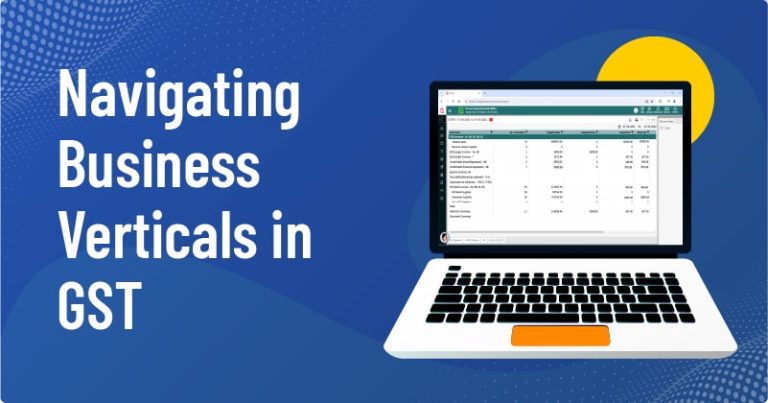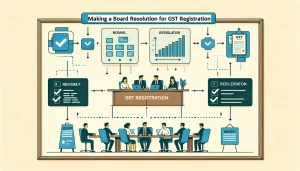In the realm of business operations in India, the Goods and Services Tax (GST) has become a pivotal factor since its implementation in 2017. Understanding how GST impacts various business verticals is crucial for entrepreneurs and businesses alike. In this blog, we’ll delve into the concept of business verticals in GST, its implications, and how businesses can navigate through them.
What are Business Verticals in GST?
Business verticals refer to different divisions or segments of a business engaged in distinct activities or services. Under GST, businesses may have multiple verticals, each with its own revenue streams, cost structures, and tax implications. Identifying these verticals is essential for accurate tax compliance and reporting.
Implications of Business Verticals in GST
- Tax Liability: Each business vertical is treated as a separate entity for GST purposes. This means that tax liabilities are calculated independently for each vertical based on its turnover and applicable tax rates.
- Input Tax Credit (ITC): ITC allows businesses to claim credits for the GST paid on inputs used in the course of business. However, ITC utilization differs among verticals, and businesses must ensure proper allocation of credits to avoid discrepancies.
- Compliance Requirements: Compliance obligations such as filing returns and maintaining records apply to each vertical separately. Failure to comply with these requirements can lead to penalties and legal consequences.
Types of Business Verticals
- Manufacturing Vertical: Businesses engaged in manufacturing activities fall under this vertical. They are required to pay GST on the value addition during the manufacturing process.
- Trading Vertical: Trading verticals involve buying and selling goods without altering their form. These businesses need to account for GST on the margins they earn through trading activities.
- Service Vertical: Service-oriented businesses offer intangible services and are subject to GST on the service charges they levy. Service verticals encompass a wide range of industries such as IT, consulting, hospitality, etc.
Challenges Faced by Businesses
- Complexity in Classification: Determining the classification of transactions across different verticals can be challenging, especially for businesses operating in multiple sectors.
- IT Infrastructure: Businesses need robust IT systems capable of segregating transactions and generating accurate reports for each vertical to ensure compliance with GST regulations.
- Transition Issues: Transitioning from the pre-GST era to the GST regime may pose challenges in terms of restructuring business operations and realigning tax strategies.
Navigating Business Verticals in GST
- Segmentation and Documentation: Businesses should clearly define their various verticals and maintain separate documentation for each, including invoices, accounts, and records.
- IT Solutions: Invest in reliable ERP (Enterprise Resource Planning) or accounting software that supports multi-vertical operations and facilitates seamless tax compliance.
- Regular Training and Updates: Keep your finance and tax teams abreast of the latest GST developments through regular training sessions and updates from regulatory authorities.
- Engage Tax Experts: Consult with tax experts or chartered accountants specializing in GST to ensure proper understanding of the regulations and effective tax planning strategies.

Additional Considerations for Businesses
- Inter-Vertical Transactions: Businesses with multiple verticals often engage in transactions between these segments. It’s crucial to understand the GST implications of such transactions to ensure compliance and avoid tax evasion.
- Reverse Charge Mechanism (RCM): Certain goods and services are subject to RCM, where the recipient of the goods or services is liable to pay GST instead of the supplier. Businesses must be aware of RCM applicability across different verticals.
- Annual Turnover Calculation: Each vertical’s turnover determines its eligibility for various GST provisions, such as composition scheme or threshold exemption. Accurate calculation of turnover for each vertical is essential to avail of these benefits appropriately.
- Place of Supply Rules: The place of supply rules under GST determine the jurisdiction where GST is payable. Businesses with operations spanning multiple states or territories must comply with these rules for each vertical.
Future Trends and Developments
- Simplification of Procedures: Efforts are underway to simplify GST procedures and reduce compliance burdens for businesses, including rationalization of tax rates and process automation.
- Digital Transformation: The increasing adoption of digital technologies such as e-invoicing and GSTN (Goods and Services Tax Network) enhancements will further streamline GST compliance and reporting for businesses across verticals.
- Harmonization of Laws: As GST evolves, there’s a growing emphasis on harmonizing state and central laws to create a unified tax structure, facilitating smoother operations for businesses operating in multiple states.
- Global Integration: With India’s push towards becoming a global manufacturing hub, businesses must align their GST strategies with international standards to enhance competitiveness and attract foreign investment.
Looking Ahead: Future Challenges and Opportunities
- Compliance Complexity: As GST regulations evolve and become more intricate, businesses may face challenges in keeping up with compliance requirements, especially for those operating in diverse verticals or across multiple jurisdictions.
- Data Security and Privacy: With the increasing digitization of tax processes, businesses must prioritize data security and privacy to safeguard sensitive financial information and comply with regulatory standards such as GDPR (General Data Protection Regulation).
- Global Trade Dynamics: The international trade landscape is undergoing significant shifts, driven by geopolitical factors and trade agreements. Businesses operating across verticals must adapt to these changes and ensure compliance with cross-border tax regulations.
- Emerging Technologies: Technologies such as blockchain and artificial intelligence are reshaping the tax landscape, offering opportunities for automation, transparency, and fraud detection. Businesses need to embrace these innovations to enhance their GST compliance and operational efficiency.
Conclusion
Navigating business verticals in GST requires a comprehensive understanding of tax laws, meticulous record-keeping, and strategic planning. By adopting best practices, leveraging technology, and staying abreast of regulatory changes, businesses can ensure GST compliance across multiple verticals while optimizing tax efficiency and mitigating risks effectively.
Also Read:
- A Simple Guide to Making a Board Resolution for GST RegistrationRegistering for Goods and Services Tax (GST) is an essential step for businesses in India. This step not only ensures compliance with the law but also boosts the credibility of a business and opens up broader opportunities. One important part… Read more: A Simple Guide to Making a Board Resolution for GST Registration
- Decoding GST on Stamp Duty: A Step-by-Step GuideUnderstanding how GST (Goods and Services Tax) and stamp duty work together can be quite challenging. Both are very important parts of the Indian taxation system and have a significant impact on various financial transactions, especially in the real estate… Read more: Decoding GST on Stamp Duty: A Step-by-Step Guide
- Difference Between Monthly and Quarterly GST ReturnUnderstanding and complying with Goods and Services Tax (GST) requirements in India involves choosing how often you file your GST returns—monthly or quarterly. This decision is crucial for managing cash flow, meeting compliance obligations, and running your business smoothly. In… Read more: Difference Between Monthly and Quarterly GST Return
- Easy GST Return Filing Services: Simplifying Your Tax NeedsThe introduction of the Goods and Services Tax (GST) in India has brought about a unified tax regime, replacing a multitude of indirect taxes previously levied by the central and state governments. While GST has simplified the tax structure, filing… Read more: Easy GST Return Filing Services: Simplifying Your Tax Needs
Frequently Asked Questions
What are business verticals in GST?
Business verticals in GST refer to distinct segments within a company engaged in different activities, such as manufacturing, trading, or services.
How does GST impact different verticals?
GST affects each vertical differently, influencing tax liability, input tax credit, compliance requirements, and operational strategies based on the nature of the business.
What are the compliance challenges for businesses?
Businesses face challenges such as classification complexities, IT infrastructure requirements, and transition issues while ensuring GST compliance across verticals.
Why is segmentation important for GST?
Segmentation helps businesses maintain separate records, track transactions accurately, and comply with GST regulations for each vertical effectively.
What are the implications of inter-vertical transactions?
Inter-vertical transactions require careful consideration of GST implications to avoid tax evasion and ensure compliance with regulatory requirements.
How can businesses optimize tax efficiency?
Businesses can optimize tax efficiency through strategic tax planning, maximizing input tax credit utilization, and leveraging technology for compliance.
What are the future trends in GST compliance?
Future trends include simplification of procedures, digital transformation, harmonization of laws, and integration with global trade dynamics.
How does GST impact international trade?
GST impacts international trade by influencing export-import procedures, customs duties, and compliance requirements for businesses operating across borders.
What role does technology play in GST compliance?
Technology facilitates automation, transparency, and efficiency in GST compliance through solutions like e-invoicing, GSTN enhancements, and data analytics.
How can businesses prepare for GST changes?
Businesses can prepare by staying updated on regulatory developments, investing in training and technology, and collaborating with tax experts for strategic guidance.









This blog is a goldmine of information!
I wish more blogs were as informative as this one.
Informative and engaging, what more could you ask for?
This blog is like having a knowledgeable friend to turn to.
I feel more informed after reading this blog.
Such a great resource for learning new things!
I learned so much from this informative blog post!